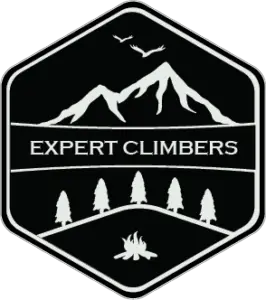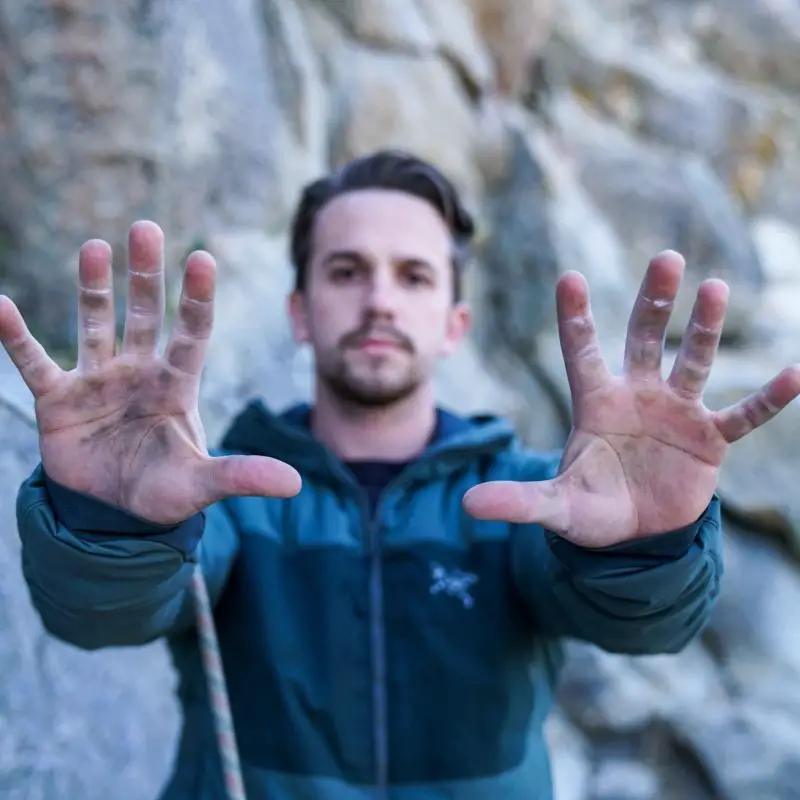As a novice, you may not have considered the need for extra skin protection for climbing. As you progress, you’ll notice those hands getting downright painful at times if you don’t take good care of your skin. So, let’s take a closer look at the importance of skin care to climbers, review some of the more common injuries you might suffer from and talk about prevention and cures.
Rule Number 1 – Keep that Skin Clean!
There are a number of horribly uncomfortable skin conditions, particularly in your hands, that happen almost exclusively as a result of clinging to a rock face at fifty feet. Understandably, climbers are highly likely to develop callouses over time. Their nails can split and crack, and some of these injuries are so common they even have their own names! Of course, caring for the hands after a climb is difficult enough – but you should put time and effort into prevention if you truly don’t want to suffer.
A climber’s hands are there most important tool. As you scale that face, you need to be able to rely on a sure and steady grip; something not possible with damaged hands. The first step to keeping them injury free is to keep them clean and dry. This is why many climbers will dry their cleaned hands with chalk before they scale any mountains. You can read a little more about chalk and why we use it in our chalk post – but for now, we want to focus on cleanliness.
Keeping your hands clean is the first rule to a successful climb for multiple reasons. Chiefly, without clean hands toughened skin tends to crack and dry out when you use climbing chalk. Slipping is a huge factor, and dirty hands are more likely to sweat. Which is why I recommend that you wash your hands several times in a climbing day to get the dirt, grime, chalk, and aluminum from the climbing rig off your hands. When climbing the skin is likely to split, and bacteria can get in and cause infections; so, you should also carry some anti-septic cream on you and apply it as needed for even small scratches.
Now that we have established the most important factor, let’s examine some of the more common skin injuries most climbers suffer from.
The Most Common Skin Injuries Among Climbers
As a sport; climbing relies heavily on the hands and feet as points of contact. For this reason, the majority of climbers will experience the following skin injuries at some point during their career:
Worn Tips
A climber with worn tips or worn out fingertips suffers from raw skin on and around the ends of the fingers. This condition is quite likely to occur after a serious climb and causes anything you touch to feel as though your fingertip is burning. The rawness of this condition means you’re particularly exposed to bacteria and at high risk of infection.
According to Web MD the skin itself is made up of three layers: the Epidermis, the Dermis and the Subcutaneous Layer. While the Epidermis is the top layer that we can see and touch, the Dermis is the middle layer that acts as a sort of the main barrier against infection; then the Subcutaneous Layer is made out of fat and connective tissues needed to hold the whole together. When you suffer from worn tips, you have rubbed away the Epidermis to some degree. When the Dermis is exposed, the skin will be raw and sore to the touch. If the Subcutaneous layer is exposed in your fingertips, you’d be in extreme danger and need to see a Doctor ASAP.
Climbers can minimize the risk of succumbing to worn tips by taking a few steps. First of all, try not to alter your grip too much. Secondly, make sure you’re using enough chalk and thirdly keep those hands clean and dry. You can also apply certain creams and salves before you climb to protect your hands, but we’ll talk more on that later. Minimizing the amount of time you’re physically gripping the wall can also help; try planning climbs that operate in short spurts and shortening the length of time you’re on the face for.
Split Tips
Split Tips are a horrible thing to suffer from – climber or not. Unfortunately, the strain put on the hands, particularly due to excessive climbing, can often result in this painful condition. Split tips occur when a thin cut appears across the sensitive parts of the fingertip. It interferes with your ability to grip and worsens over time. These can be caused by excessive use of chalk as well as a propensity towards a particular form of dermatitis.
Contributing factors can include extremities of weather, hands that are too dry and on rare occasions, chemical contact on the skin can cause it. That Aluminum climbing kit you have is leaving trace mineral content on your skin that is only added to with every grip you take. As with most climbing-induced skin conditions, the best way to deal with split tips is to actively avoid them. Again, we need to reinforce the power of a good hand wash.
Many climbers make the mistake of never allowing their hands to get wet, but this can lead to a worsening of split tips. Instead, try a good moisture-based hand wash and moisturize your hands to keep your them supple – then dry them out with chalk only during your climb. This way you get the best of both worlds and can actively combat the split tips. Of course, there are other ways to cure this condition, or at least to prevent it – but more on that later.
Gobies
Gobies is an affectionate name that the hardened climber gives to the bruises, bashes and scrapes their hands endure when they climb. Most commonly, Gobies are caused by sticking your hands in cracks, hours of climbing endurance or even just a few meters of particularly rough rock. When these small injuries add up it can mean less grip and more frustration so, as ever, prevention is better than cure.
Proper chalking, a good examination of your climbing surface and the right creams can all harden the hands to stop Gobies forming mid-climb. Unfortunately, they tend to be a little unavoidable in the climbing world. Let’s face it; if you’re going to be scaling a rock wall, you’re going to put a lot of pressure on those mitts, and if they aren’t properly taken care of, you can expect bruises, cuts, and scrapes that scab after your climb.
Gobies scab over on the epidermal layer so that the dermis can properly heal over time. It has been suggested that bandaging the hands can speed the recovery process. However, regular cleaning and keeping the wound covered, as well as the use of an anti-septic cream as soon as possible, is the best way to treat a Gobi… at least according to Steve Hong; a dermatologist familiar with the problems faced by climbers.
Flappers
Flappers are probably the most unpleasant of the common injuries experienced by climbers. This is because they tend to do long-lasting damage that needs to be fixed. Professional climbers will spend years finely honing their callouses to give them optimal grip. When a flapper happens, these callouses are torn loose from the skin to hang, unsightly and usually bloody, from the dermal layer.
For the purposes of finishing your climb; taping that skin back on again and continuing might be the only way forward. However, you need to tend to that wound straight away and, in spite of popular belief, I’ve noticed that taping a flapper back to your finger never allows it to ‘reconnect’ with the tissue. Instead, the flap of skin will rot off, and you’ll need to rebuild that wonderful callous.
Treatment recommendations are to finish your climb, remove the tape and carefully remove the flap of skin with a sterilized implement (i.e. if you’re going to use scissors make sure they are clean), then wash and dry the area thoroughly. Allowing the wound to air dry is key here, just remember the dermis is exposed, so infection is possible and keep an eye on it.
Preventing and Treating these Common Climbing Skin Conditions
There are numerous ways in which we can actively prevent or treat any of the above conditions. We have summarized some of these below.
Sanding
Sanding your hands might seem a little harsh, but it’s by far the best way to avoid flappers in particular. Those hard callouses can be the cause of some pretty nasty nicks when the action of repetitive climbing tears them loose. This often happens because the thickness of the callous is disproportionate to the skin and, once it becomes so thick that the epidermis can no longer hold it, the callous will flap off. Sanding keeps those callouses thinner, so you still get that grip but without the added risk.
It also helps that callous form into a single layer instead of individual, peelable ones. Use sanding to develop those callouses and prevent against injury.
Salves and Creams
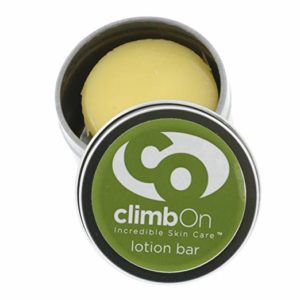
Salves, balms and creams can be both a preventative measure and a cure. They’re generally used before a climb in order to prevent injury and after an injury to prevent infection, to stop inflammation or for some other medical purpose. An Anti-septic salve is the most important thing in
your kit. If you don’t want those hands to become infected every cut needs to be treated. My favorite salves for preventing blisters are Climb on and Joshua Tree as some of the best and most affordable for preventing blisters (click on the names to buy them on Amazon).
Moisturizing
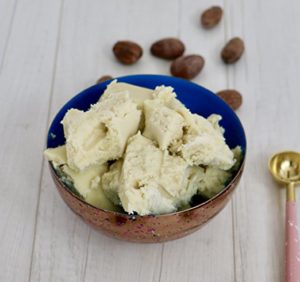
Things like Cocoa butter, Shea butter, and Almond oil can all soften the hands when needed – sort of the opposite to what a pro climber wants. However, they also lock in moisture that is vitally important when you’re going to be covering your hands in chalk for long periods of time. Moisturizing is important.
Whether or not hands should be exposed to humidity is a much-contended point. Some climbers will purposefully never allow their hands to get wet. Unfortunately, this is conducive to cracked and split tips. Getting the balance correct for your skin type is vitally important and, unfortunately, there is no sure-fire method to learning which cream will work for you. Trial and error seem to be the best way to find out; I, for one use unrefined Shea butter (click here to see the price on Amazon), it has an earthy, nutty smell but it’s healing properties are amazing!
Hydration and Diet

Like most things in life that are any fun, climbing is seriously affected by your hydration level and how clean your diet is. Avoiding refined sugars and overly processed foods isn’t just good for your muscles and bones, it also helps speed your recovery time from injury, protects your skin and helps prevent against climbing-related issues.
One of our favorite snacks is trail mix. Dried fruits and nuts contain high levels of vitamins and minerals essential for bodily repair and optimum functioning. Iron, potassium, phosphorous, calcium, zinc and copper are all common ingredients in trail mix. Some nuts, such as the humble walnut also contain vitamin c, which speeds the rate at which the body absorbs these minerals and therefor the rate at which you recover from injury.
Other vitamins and minerals to look out for are vitamin E, which promotes skin health, Copper and Zinc, which promote elasticity of the skin and Vitamins A and D, both of which are strong anti-oxidants which will help fight off any potential infections. Getting enough water will do all of the above and will also help the body get rid of the excess vitamins it doesn’t need, so always stay hydrated and eat well before a climb.
Our Favorite Must-Haves for climber’s Skin Care
As we have established there are numerous skin conditions that can affect a climber’s grip. With that in mind we put together a list of what we consider to be ‘must-haves’ for climbers’ skin care.
Sander
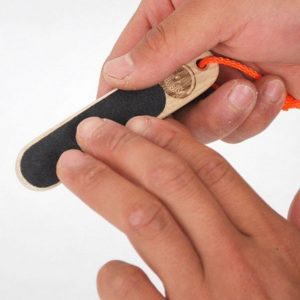
A sander is a necessary part of your gear to keep those callouses in check. We recommend a pumice stone or even a fine grade of commercial sandpaper – just don’t go blasting your fingers with a commercial grade motorized sander and all should go well. Sanding is vital because callouses grow out from your skin in layers. Each time your top layer of skin is worn away (as in a worn tip) the skin will regrow slightly harder, forming a new protective epidermal layer to do so.
When this happens, your hand effectively grows a new layer of skin on top of the old one in a process which is then repeated every time you climb. After a hundred climbs you could end up with a hundred layers – as you can imagine the body then tries to shed this skin because it’s too heavy for the cells that attach it to the body. This is how flappers develop. Sanding down the callous smooths the edges where the regular skin joins the callous so that the transition is smooth. Smooth skin means it’s less likely to tear. The moral of the story? Put a pumice stone in your kit!
You’ll need: a pumice stone (Amazon), a piece of fine sandpaper or a skin file (Amazon).
Liquid Bandage
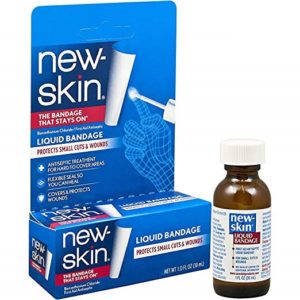
You may have heard tell of the Yosemite climbers who superglue fingers together, or of climbers super gluing shut a wound in the middle of a climb so they don’t get stuck. This is why the liquid bandage is an important part of every climber’s kit. Replace that superglue with liquid bandage in the modern, more health conscious, equivalent of superglue and it can give you all sorts of protection… just like the glue does for the Yosemites.
As well as giving you the ability to clean and seal a wound while you’re on the go, liquid bandaging can be used in place of plasters and bandages to stop the discomfort of flapping textiles rubbing against the skin. It has an added use for gluing down any bandages or fabrics you do use so that they don’t irritate you.
A good liquid bandage will ensure that you have protection for skin flaps, that your hands won’t develop split tips if they’re bound up and that you’re always ready to fight infection…. for God’s sake put the superglue down and step away from the bottle!
You’ll need: Liquid a bandage such as this one from New Skin.
Alcohol/Hydrogen Peroxide
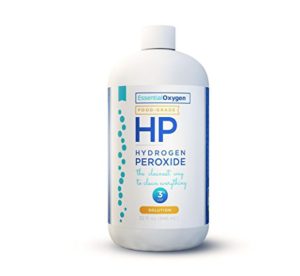
An essential tool in any first aid bag, alcohol or hydrogen peroxide should also be kept with your climbing gear. It’s a well-known fact that either rubbing alcohol or peroxide are able to effectively clean every single germ out of a dirty wound. Controversially perhaps, the National Health Service of Great Britain advises that you use an alcohol-free wipe instead, since European standards find that alcohol sometimes isn’t conducive to healthy healing of a wound.
That being said, there is nothing better to ensure all bacteria is dead in an emergency. When you’re out in the wilds with limited access to (undeniably) clean water then rubbing alcohol or hydrogen peroxide has the potential to save your life. The reason Europeans use Alcohol-free wipes is that either of these chemicals will kill all bacteria – that includes healthy ones trying to heal your wound for you. When you’re in the field, however, alcohol can also be used to ensure that any other medical or food equipment you need to use is sterilized, which makes it a vital part of your gear.
Rubbing alcohol is especially important as a way to keep your hands cleaned in between faces. It sanitizes, allowing you to reapply your chalk and clean any nicks or cuts you may have picked up. A word of caution though – alcohol will also reduce the rate at which your blood clots and will slow down how long it takes your wounds to stop bleeding… applying it to the wrong type of injury might be worse than washing the wound with potentially dirty stream water.
You’ll need: Rubbing Alcohol or Hydrogen Peroxide. Hand Sanitizers are also a good idea like this one from Purell.
Nail Clippers/Nail File

It might sound like vanity, but nail clippers are a really useful piece of kit when you’re a climber. Sanitize them with the alcohol mentioned above before use and then use them to trim any loose flaps of skin, tidy up any cracks on your fingertips or keep those nails short if they’re splitting or interfering. Your grip is what keeps you from plummeting to death out there – don’t let ragged nails be your downfall.
According to UK Climbing, trimming down the nicks around the cuticle of the nails is one of the best things you can do for your hands as a climber. It’s these little loose pieces of skin around the cuticle that can be torn and bleed, causing you pain every time you grip. Get rid of them with your sanitized nail clippers because we all know if you give in to an urge and bite with your teeth the result will be painful.
Nail files are also a must-have. A ragged nail that has split in half has the probability of getting much worse before it gets better. Often filing away the ragged edge before the nail splits is the best way to prevent a broken nail from causing you a valid injury. A torn nail is painful, so file it down and don’t take the chance.
You’ll need: a nail file and a pair of nail clippers (Amazon), although a small pair of scissors are equally viable and may have even more potential uses when in the wilderness.
Razor Blades
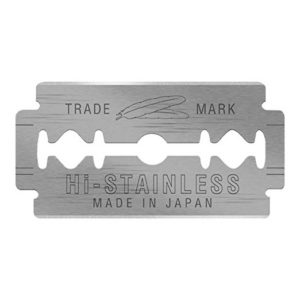
Razor blades can be used to trim loose skin from flappers down as close to the finger as possible. They can trim down split tips or be used to make taping up wounds easier all round. Not to mention that the razor blade has many applications when out in the wild for cutting and preparing.
Make sure that any razor blade you put near your skin is new and clean with no rust whatsoever. As with the nail clippers, before you use it, you should sterilize it with rubbing alcohol beforehand. Make sure your razor blades are not left loose in your bag or you might make a bad injury worse. Also, throw them away as soon as they have been used to prevent infection from a dirty blade in the future.
You’ll need; a pack of razorblades (Amazon) and something to carry them in.
Climber’s Tape
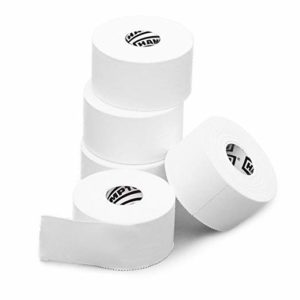
This is the tool you’ll come to depend on the most. Before every challenge, clean and dry your hands, apply your tape and then chalk up. Tape ensures you have maximum grip as well as providing extra strength by support; it allows you to combine fingers together and ensure you can better carry your body weight and it has the additional benefit of providing an extra barrier of protection to your hands without having to resort to gloves.
Tape won’t grip holds as well as your natural skin does, nor can it fully protect your hands from damage, although it does prevent skin from tearing and ripping as easily. Many climbers tape up the palms of their hands instead of their fingers to ensure the best balance of padding and grip. We do advise that the new climber relying on tape isn’t doing himself any favors. This is because the pain in your hands is how you grow callouses and tape works against this, so use it at your own discretion.
You’ll need: climber’s tape (Amazon).
Final Thoughts
Hands, fingers and skin should be on your mind every time you climb and even for the few weeks running up to a big climb. Without proper skin care, your hands will suffer, which will make grips twice as difficult and holding your own weight becomes a risky process. Don’t take the risk, follow our guide and keep those hands protected so that you can survive to climb another day!
